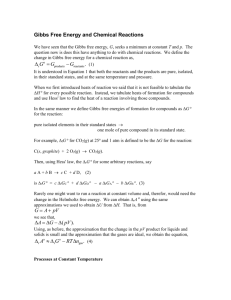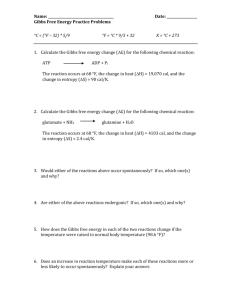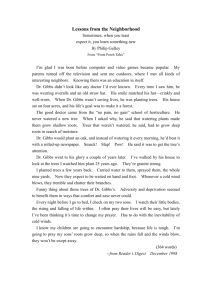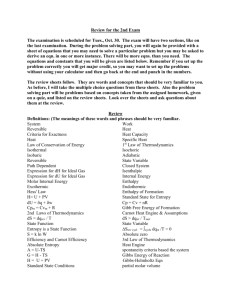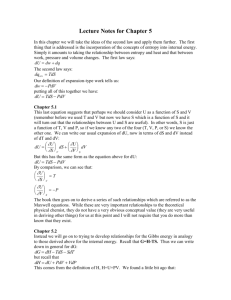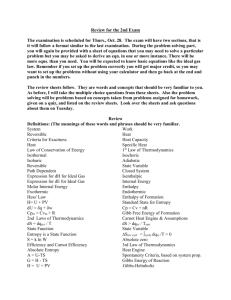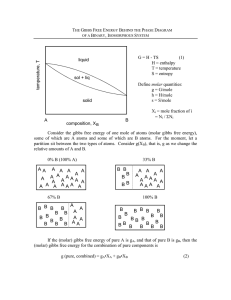GEOL 2312 IGNEOUS AND METAMORPHIC PETROLOGY Lecture
advertisement
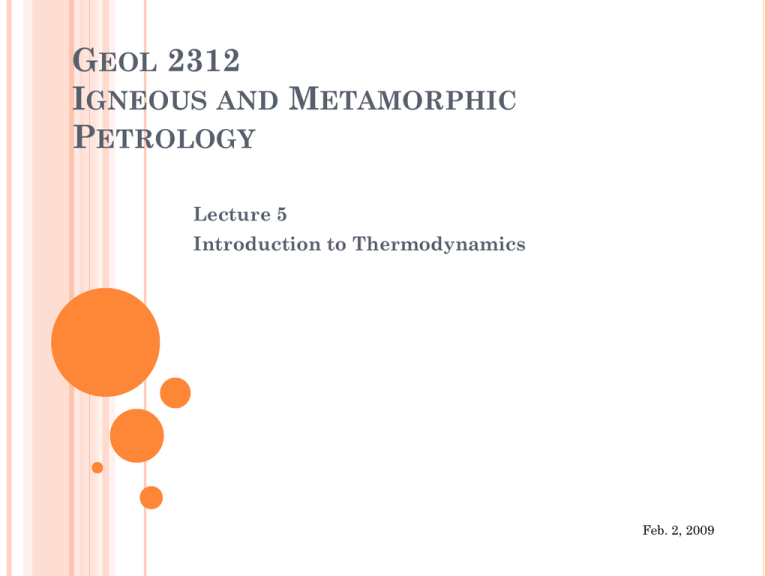
GEOL 2312 IGNEOUS AND METAMORPHIC PETROLOGY Lecture 5 Introduction to Thermodynamics Feb. 2, 2009 THERMODYNAMICS IS THE STUDY OF THE RELATIONSHIPS BETWEEN HEAT, WORK, AND ENERGY SYSTEM- Some portion of the universe that we wish to study SURROUNDINGS - The adjacent part of the universe outside the system Changes in a system are associated with the transfer of energy from one form to another Energy of a system can be lost or gained from its surroundings, but collectively energy is conserved. Types of Energy include: Potential Kinetic Thermal Gravitational Chemical Mechanical STATES OF ENERGY NATURAL SYSTEMS TEND TOWARD STATES OF MINIMUM ENERGY Stable – at minimum energy state Unstable – energy state in flux (disequilibrium) Metastable – temporary energy state that is not lowest, but requires energy to push it to lower energy state GOOD THING FOR GEOLOGY! Winter (2001), fig. 5-1 GIBBS FREE ENERGY MEASURE OF THE ENERGY CONTENT OF A CHEMICAL SYSTEM All chemical systems tend naturally toward states of minimum Gibbs free energy (G) G = H - TS Where: G = Gibbs Free Energy H = Enthalpy (heat content) T = Temperature in Kelvins (=oC + 273) S = Entropy (randomness) Basically, Gibbs free energy parameter allows us to predict the equilibrium phases of a chemical system under particular conditions of pressure (P), temperature (T), and composition (X) EQUILIBRIUM OF A CHEMICAL REACTION Phase - a mechanically separable portion of a system (e.g., Mineral, Liquid, Vapor) Reaction - some change in the nature or types of phases in a system. Written in the form: Reactants Products e.g. 2A + B + C = 3D + 2E To know whether the products or reactants will be favored (under particular conditions of T, P, and X, we need to know the Gibbs free energy of the product phases and the reaction phases at those conditions DG = S (n*G)products - S(n*G)reactants = 3GD + 2GE - 2GA - GB - GC If DG is positive, the reactants are favored; if negative, the products are more stable GIBBS FREE ENERGY OF A PHASE AT ITS REFERENCE STATE It is not possible to measure the absolute chemical energy of a phase. We can measure changes in the energy state of a phase as conditions (T,P,X) change. Therefore, we must define a reference state against which we compare other states. The most common reference state is to consider the stable form of pure elements at “room conditions” (T=25oC (298oK) and P = 1 atm (0.1 MPa)) as having G=0 joules. Because G and H are extensive variables (i.e. dependent on the volume of material present), we express the G of any phase as based on a quantity of 1 mole (called the molar Gibbs free energy). MOLAR GIBBS FREE ENERGY OF FORMATION With a calorimeter, we can then determine the enthalpy (Hheat content) for the reaction: Si (metal) + O2 (gas) = SiO2 DH = -910,648 J/mol Since the Enthalpy of Si metal and O2 is 0 at the reference state, the value for DH of this reaction measures is the molar enthalpy of formation of quartz at 298 K, 0.1MPa. Entropy (S) has a more universal reference state: entropy of every substance = 0 at 0 oK, so we use that (and adjust for temperature) Then we can use G = H - TS to determine molar Gibbs free energy of formation of quartz at it reference state DGof = -856,288 J/mol DETERMINING THE G OF A PHASE AT ANOTHER TEMPERATURE AND PRESSURE The differential equation for this is: dG = VdP – SdT V/dP – isothermal compressibility S = Cp/T, Cp – heat capacity (heat required to raise 1 mole of substance 1°C) Assuming V and S do not change much in a solid over the T and P of interest, this can be reduced to an algebraic expression: GT2 P2 - GT1 P1 = V(P2 - P1) - S (T2 - T1) and G298, 0.1 = -856,288 J/mol to calculate G for quartz at several temperatures and pressures Low quartz Eq. 1 SUPCRT P (MPa) T (C) G (J) eq. 1 G(J) V (cm3) S (J/K) 0.1 25 -856,288 -856,648 22.69 41.36 500 25 -844,946 -845,362 22.44 40.73 0.1 500 -875,982 -890,601 23.26 96.99 500 500 -864,640 -879,014 23.07 96.36 GIBBS FREE ENERGY FOR A REACTION SOLID LIQUID Here, X is constant (one comp) so we just have to consider affects of T and P on G dG = VdP – SdT We can portray the equilibrium states of this reaction with a phase diagram What does this say about the DG of the reaction at Points A, X, and B? High temperature favors randomness, so which phase should be stable at higher T? High pressure favors low volume, so which phase should be stable at high P? Let’s look at the effects of P and T on G individually TEMPERATURE EFFECT ON FREE ENERGY dG = VdP - SdT at constant pressure: dG/dT = -S Because S must be (+) G for a phase decreases as T increases Would the slope for the liquid be steeper or shallower than that for the solid? TEMPERATURE EFFECT ON FREE ENERGY Slope of GLiq > Gsol since Ssolid < Sliquid A: Solid more stable than liquid (low T) B: Liquid more stable than solid (high T) Slope dP/dT = -S Slope S < Slope L Equilibrium at Teq GLiq = Gsol = crystallization/melting temperature PRESSURE EFFECT ON FREE ENERGY dG = VdP - SdT at constant temperature: dG/dP = V Note that Slopes are + Why is slope greater for liquid? PHASE DIAGRAM PORTRAYS THE LOWEST FREE ENERGY SURFACES PROJECTED ON TO T-P SPACE From Philpotts (1990), Fig. 8-2 MELTS DETERMINES PHASE EQUILIBRIUM BASED ON THERMODYNAMIC MEASUREMENTS PELE – MELT FOR PC USE A. BOUDREAU 2002

